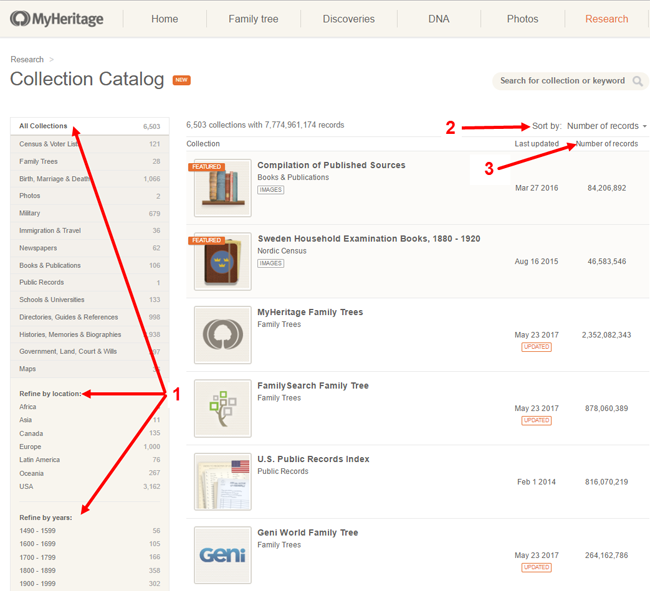3 Top Uses for the New MyHeritage Collection Catalog
 The new MyHeritage Collection Catalog is making the site even easier to use. Read our 3 favorite uses for the new MyHeritage Collection Catalog, and a description of how MyHeritage counts its records.
The new MyHeritage Collection Catalog is making the site even easier to use. Read our 3 favorite uses for the new MyHeritage Collection Catalog, and a description of how MyHeritage counts its records.
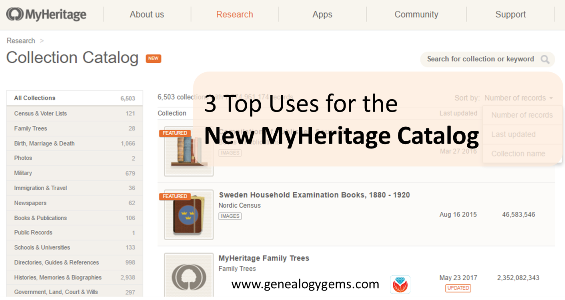
The new MyHeritage Collection Catalog has just been released, and is dedicated to searching records collections on the site. It’s a public catalog, available whether you are a subscriber or not, so now you can easily see whether MyHeritage may have the historical records you need.
It’s a public catalog, available whether you are a subscriber or not!
“The new Collection Catalog provides a useful listing of the collections on SuperSearch and is a gateway to the vast historical treasure trove of 7.8 billion records currently offered by MyHeritage,” says a MyHeritage press release. “The catalog lists our 6,503 main collections and excludes tiny collections that have fewer than 500 records each.” (Those may be added to the catalog later on.)
Here are 3 top uses we see for the new MyHeritage Collection Catalog:
1. Look for specific record types for a particular place and time period. Use the left side menu to select record types, locations and time periods. Within many of those, you’ll be able to choose more specific subcategories. You can also do keyword searches if you’re generally looking for particular kinds of records (“newspaper” or “church”).
2. See what’s new on the site, or what collections have been recently updated. To see what’s been added or updated lately, roll over Sort by and select “Last updated.” You’ll also see a little tag on any collections that are new or have been recently updated. This helps you to know whether you’re seeing the most recent data available, particularly in collections they index from other websites, such as the FamilySearch Tree or Geni World Family Tree.
3. See how many records are in a collection. This may help you determine how comprehensive a particular database might be, and compare how many records for a particular place are on their site.
Speaking of record counts, MyHeritage also shared a description of how they count records. I’m really encouraged to see a major records site do this and I hope this trend continues! In our newest quick reference guide, Genealogy Giants: Comparing the 4 Major Websites, we talk about how difficult it is to compare record content on different genealogy websites because there’s no uniform standard for counting them, and they don’t all define their counting methods alongside their site statistics. Here’s MyHeritage’s description of how they count records:
“In structured collections, such as census records, birth, and marriage records, each individual name is counted as one record. For example, a marriage document naming both the bride and groom is counted as two records. Nicknames or aliases are not counted as additional records. In family trees, each tree profile is counted as one record, even when it is available in more than one language. Each photo is counted as one record. In unstructured collections, such as newspapers or yearbooks, each page is counted as one record even though it may include hundreds of names. We count each page as a single record because we don’t want to inflate the record count by guessing.” (MyHeritage previously published this information in a 2014 blog post.)
Getting the Most from MyHeritage
Here at Genealogy Gems we strive to help you get the most out of the genealogy websites you choose to use in your research. In the case of MyHeritage, we’ve got two jam-packed quick reference guides like no others on the market:
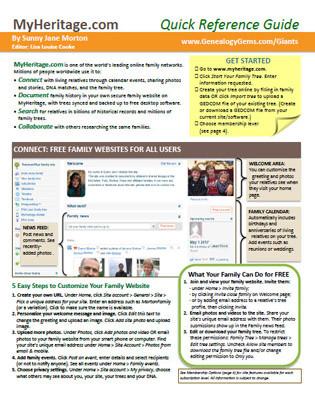 MyHeritage Quick Reference Guide: Newly Updated in 2017!
MyHeritage Quick Reference Guide: Newly Updated in 2017!
This guide shows you how to:
- create a family website on MyHeritage (and help your relatives use it for free),
- build your family tree,
- research records and others’ trees,
- get the most from the built-in search tools,
- test or upload your DNA and work with DNA matches,
- quickly navigate the website, and choose the best membership plan (free or paid) for your needs.
Genealogy Giants: Comparing the 4 Major Websites: NEW in 2017
This comprehensive guide helps you answer the question, “Which genealogy records websites should I use?” You’ll learn:
 How knowing about all four websites can improve your family history research
How knowing about all four websites can improve your family history research- How the sites stack up numerically for historical records, names in trees, DNA profiles, site users, site languages and subscription costs
- Unique strengths of each website and cautions for using each
- What to keep in mind as you evaluate record content between sites
- Geographic record strengths: A unique table has an at-a-glance comparison for 30+ countries
- How to see what kinds of records are on each site without subscribing
- How family trees are structured differently at these websites—and why it matters
- Privacy, collaboration, and security options at each site
- How DNA testing features differ at the two websites that offer it
- What you can do with free guest accounts at each website
- Subscription and free access options
Thanks for sharing this post with others who will want to know about the new MyHeritage Catalog! You are a Gem!
How to Upgrade Your DNA Test with Your DNA Guide
When it comes to chocolate my general rule of thumb is that more is usually better! The same is true with DNA testing. With this big DNA test upgrade sale, now is the perfect time to get MORE! I love being Your DNA Guide here at Genealogy Gems, and today I’ll walk you through how to get the best deal and the right tests. Take my hand, and let’s get upgrading!

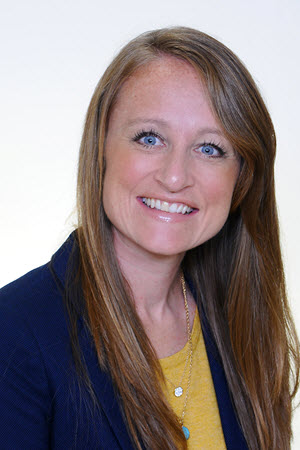 This month, Family Tree DNA is running this Family Tree DNA’s Friends & Family sale, which means that all of the kits and upgrades are on sale! This sale is the perfect time to upgrade your DNA tests. (By clicking our link above you are supporting the free Genealogy Gems Podcast. It doesn’t cost you anything extra, and we will receive compensation from the affiliate link. Thank you!)
This month, Family Tree DNA is running this Family Tree DNA’s Friends & Family sale, which means that all of the kits and upgrades are on sale! This sale is the perfect time to upgrade your DNA tests. (By clicking our link above you are supporting the free Genealogy Gems Podcast. It doesn’t cost you anything extra, and we will receive compensation from the affiliate link. Thank you!)
Once in your account, click the Upgrade button. In very basic terms, to Upgrade means that they are going to go back to your DNA sample that they have on file, and do more testing.
Depending on the tests you have already had completed at Family Tree DNA, you will see several different options in the Upgrade menu. Most of you will see this box, listing the option to do more advanced testing, find gene variants, or order certificates.
If you’re testing for general genealogy purposes, you can most likely ignore all of those options. The advanced testing is aptly named as it is only for very specific, very, advanced problems. The gene variant report can be interesting, but you can get a similar report for only $5 from Promethease.com. As for the certificates, that is up to you. It is a printed report of your DNA values for either your YDNA or your mtDNA test. These are nice to give to relatives that have tested for you that might want something tangible to hold as evidence of their participation in your genetic genealogy efforts.
The last option in this box is to have a personalized report written. This will be several pages of information about the DNA testing you have had completed, but don’t expect them to find your ancestors or do much interpretation of the results.
Beyond those options, if you have not had mitochondrial DNA testing completed, or if you have only had the lower mtDNAPlus test completed, you will see options to evaluate your mtDNA. If you are going to try to do family history with your mtDNA test, you need to have the Full Sequence test completed. For the most part, using mtDNA in your family history won’t get you very far, but it is a good record of your direct maternal line.
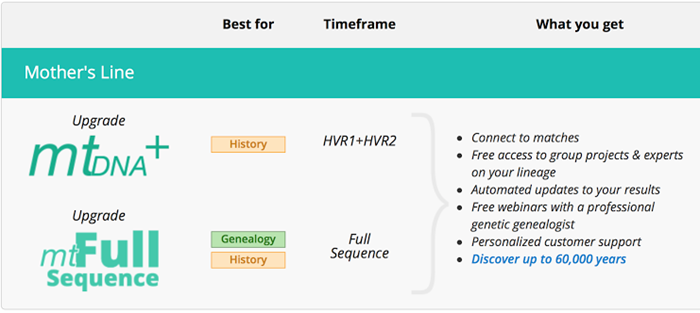
If you are a man with the YDNA test, you will also see options to upgrade your YDNA test to a higher number of markers. You will want to upgrade from 37 to 67 or 111 if you have other matches on your match page who have also tested at those higher levels and you would like to get a better comparison. You can check to see if they have tested at a higher level by looking at your match page under their name. In general, the 67 marker test will help you better decide if you are or are not related to someone, while the 111 marker test will help you better determine how you are related to known connections on your match list.
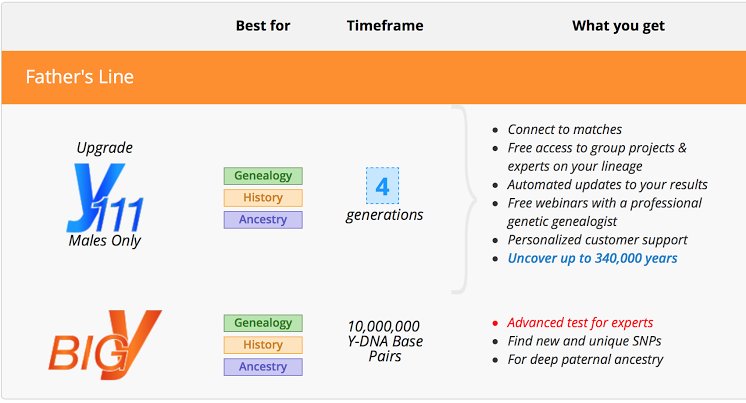
If you have not yet taken the Family Finder test at Family Tree DNA, that option will present itself as well. If the person tested is still available for testing, you should actually start their autosomal DNA testing experience with AncestryDNA, then transfer for free into their FTDNA account. If your family member is deceased, then you can get permission from their closest living relative, or whoever is administrating their account, to have them tested on the Family Finder test at Family Tree DNA.
So remember my general rule of thumb when it comes to chocolate and DNA testing, more is usually better. Click here to shop the Family Tree DNA Friends & Family!
Get more help with my quick guide: Understanding Family Tree DNA.
Unclaimed Persons Project Offers Opportunity to Apply Your Genealogy Skills
When the recent press release from the Unclaimed Persons project crossed my desk, it jumped out at me in a very personal way. I majored in Forensic Anthropology (the study of human remains) in college, and was no stranger to coroner’s offices. I’ve witnessed first-hand what happens when a decedent enters a morgue, and it’s a very cold (literally!) and lonely experience. My passion for forensics stemmed from a desire to ensure that families wouldn’t be left wondering what happened to their loved ones. The Unclaimed Persons project focuses on the other side of that mission: ensuring that the loved one is reunited with their family and laid to rest with dignity.
![By P.J.L Laurens (Own work) [CC BY-SA 3.0 (http://creativecommons.org/licenses/by-sa/3.0)], via Wikimedia Commons Unclaimed Persons Project - image By P.J.L Laurens (Own work) [CC BY-SA 3.0 (http://creativecommons.org/licenses/by-sa/3.0)], via Wikimedia Commons](https://lisalouisecooke.com/wp-content/uploads/2017/07/unclaimed-person-2.jpg)
From an Unclaimed Persons project press release:
Alone in death and tucked away on dark shelves or cold gurneys in morgues across the country, thousands of deceased individuals whose names are known to coroners, medical examiners, and a handful of friends have no known family members to claim their remains. Homelessness, mental illness, long-term estrangement, deaths of all apparent next of kin, and other circumstances have severed familial connections. Ever-increasing caseloads and shrinking budgets make it nearly impossible for medical examiners, coroners, and investigators who cannot quickly identify family to find deceased individuals’ relatives without help.
Unclaimed Persons project uses genealogy skills
Many people are aware that it can be a real challenge when a coroner obtains a John or Jane Doe, an unidentified person. It presents the difficult task of identifying the person. But few people know that in fact the even bigger problem consuming morgues today is unclaimed persons, rather than unidentified ones: individuals who have passed but with no trace of living relatives to come and claim them. Thus, the Unclaimed Persons project was born! In 2008, genealogy author, speaker, consultant, and on-air expert Megan Smolenyak Smolenyak started this organization online. She shares how she got started working with these cases in this video:
“My first time that I worked with a coroner’s office was actually sort of an accident. I was just reading the newspaper and I tripped across this article about the situation of these people who are essentially unclaimed people, people whose next-of-kin just can’t be found. And I was reading about a couple of the actual examples they gave, and one of them made a fleeting reference to a particular case where they actually had the fellow’s family bible. And that’s what made the connection for me that ‘Aha! Maybe I can use the genealogical sleuthing skills to find these families as well.” -Megan Smolenyak Smolenyak
After assisting two coroners with unclaimed persons cases, Megan founded a Facebook group with the goal of solving even more unclaimed persons cases. The online community of volunteer researchers joined forces with medical examiners, forensic investigators, and coroners to help reunite families and bring closure so that the dead can finally be laid to rest.
Unclaimed Persons is now celebrating their 9th anniversary with the launch of their new website, and to date have solved 471 cases with a 70% solve rate! But the unclaimed epidemic in morgues persists, and Unclaimed Persons is always recruiting more volunteers. As it turns out, family history enthusiasts make some of the best detectives in these cases! Genealogists combine classic sleuthing skills with their knowledge of family record keeping to track down even the most elusive relatives. This is a wonderful opportunity for genealogists to use their specialized training for an even greater good.
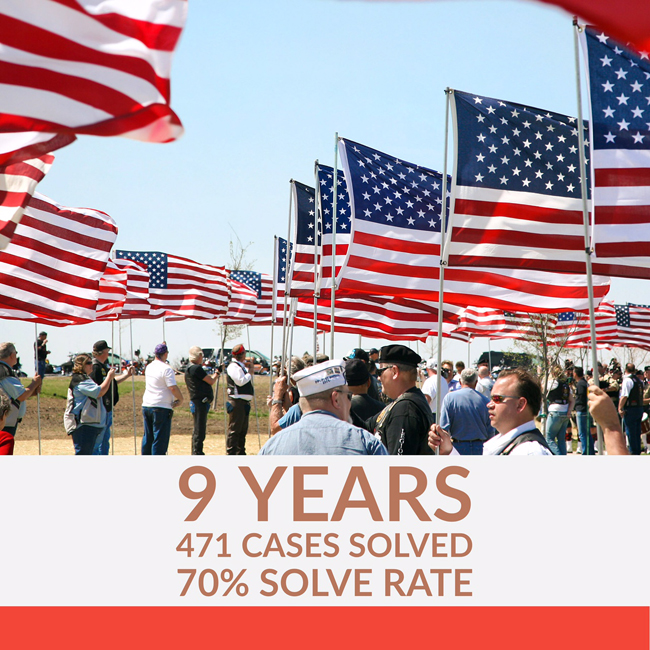
500+ veterans escorted the unclaimed remains of seven Iowa veterans to their final resting place at the Iowa Veterans Cemetery, Van Meter, Iowa, in 2009. U.S. Navy photo by Senior Chief Petty Officer Gary Ward
How you can help the Unclaimed Person project
You don’t have to be a seasoned genealogist to be a volunteer! Anyone with an interest is welcome to join. Visit https://unclaimed-persons.org/ to register as a member. You will need to complete a member profile with your basic information, and agree to Unclaimed Persons Forum Rules. Unclaimed Persons encourages researchers to have access to tools such as Ancestry.com, GenealogyBank.com, historical newspaper archives, and other online subscriptions related to genealogical research. However, there are many publicly available online databases that can also help with your research.
As an Unclaimed Persons volunteer, one of the most important things to know and adhere to is that researchers should not contact identified family members, nor should they contact coroners directly. Each case is assigned a case manager, and all discoveries should be sent directly to them. This may seem like an unnecessary step, but in fact it ensures that coroners, medical examiners, and investigators are not inundated or hindered with duplicate information and can continue to manage their daily workloads.
And Unclaimed Persons feels very strongly that contacting even one family in error would jeopardize the high standards and reputation of the organization. While the ultimate goal is bring closure for family members, the primary focus of Unclaimed Persons is to assist these agencies with the difficult task of locating them, rather than to be the ones delivering the news directly. But for your own sense of closure, Unclaimed Persons will announce on their Facebook group page and their online forum when a case has been solved so you and the other volunteers can celebrate together!
 If you don’t have time or resources to help with research, you can still help Unclaimed Persons by ‘Liking’ their Facebook page and sharing the cases among the genealogy community. You can also follow Unclaimed Persons on social media for announcements of new cases where you may have information or experience that can help (specific locations, surnames, etc.).
If you don’t have time or resources to help with research, you can still help Unclaimed Persons by ‘Liking’ their Facebook page and sharing the cases among the genealogy community. You can also follow Unclaimed Persons on social media for announcements of new cases where you may have information or experience that can help (specific locations, surnames, etc.).
Click here to learn more about how to become a volunteer member.

